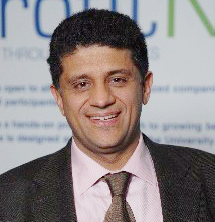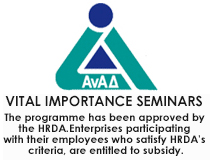Building up Innovation through Networking, Partnering and External Funding

Instructor
-
 George TsekourasDr, DPhil, Director of CENTRIM
George TsekourasDr, DPhil, Director of CENTRIMDr. George Tsekouras is the Director of CENTRIM. He has led the research in the area of innovation and entrepreneurship in areas like peer-to-peer learning networks, innovation coaching, planning and implementing new product development strategies, fostering linkages with external research, open innovation for SMEs, public-private innovation partnerships and innovation in social enterprises.
He is the founder of a number of peer-to-peer learning networks in UK, Ireland, South Africa and Greece, which have supported more than 2,000 SMEs around the world. He was the coordinator of the RAPPORT consortium (www.rapport-project.eu), which looked at best practices to connect SMEs to the public or private research organisations. Currently, he works for a consortium that helps the European Commission to design the SME Instrument scheme, a new scheme to support innovation by European SMEs.
George has also worked in other innovation areas like innovation benchmarking, industry forecasting and business process re-engineering. He has a first degree in mechanical engineering and a DPhil in innovation management from SPRU at the University of Sussex. He is the author of a number of papers in academic journals, books and international conferences while he has designed and delivered many executives training and consultancy programmes on innovation-enabled entrepreneurship.

Recent Participants

Date
- Jun 12 - 18 2020
- Expired!
Cost
- Fully Subsidized
Location
“Small Enterprises usually enjoy abundant creativity but innovation is much more than creativity. New strategies, new systems and new policy instruments support Small Enterprises to source knowledge from outside the enterprise, access external funds and other resources and partner with other SMEs, universities, large enterprises but also the crowd and talented individuals.
The challenge for Small Enterprises is to find them and manage them successfully in order to generate value for themselves and their customers”
The need to innovate is growing constantly today. Customers are more demanding, change their preferences much more often and request tailored products and services. Information corrodes the competitive advantage of traditional sectors (e.g. e-Bay) while knowhow needed to design new products and services becomes more complex. The flux state of the economy adds a further burden to competitiveness. Recent statistics reveal a shocking picture with more than 50% of the large companies disappearing from the market since the middle 1990s. If this is the case for large corporations with a lot of power, resources and networks, it is, even more, pressing for the small business which suffer from a shortage of resources! Small Enterprises need to innovate if they want to grow – some say if they want to survive In the long-term. Innovation takes a different shape depending on the stage of the company’s lifetime.
Younger Small Enterprises enjoy abundant reservoirs of creativity; their leader(s) have several ideas of how to approach a market in a ‘fresh’ way and how to offer a radical new solution to existing customers or even approach a new set of customers. However, innovation requires much more than creativity. Innovation is about using the creative ideas to ‘complete the journey’, for instance finding the funds and other required resources, identifying suitable partners, form a relationship with them and most importantly making sure that the Small Enterprises captures the value out of the developing innovation. In several cases young Small Enterprises fail to do this; typical example the young company overwhelmed from the power of (their) fresh ideas while underestimating the significance of market alliances.
On the other hand, more established Enterprises need to evolve by infusing a substantial amount of change and by rediscovering themselves, their products and their services. In practice, this means that these businesses must be prepared to ‘kill’ their habits and routines, move away from existing markets and customers and identify new fresh approaches towards growth and profits. However, this transition involves a lot of risks that may be detrimental to the company. For instance, following the track of a wrong new idea may lead the company in financial trouble. Moreover, the new strategy may require to write-off existing partnerships, identifying new partners, acquiring special systems and specific areas of expertise while for sure it requires extra resources. Most critically the new strategy has to be implemented in the absence of previous experience or considerable know-how.
The fast development of the Internet and IT systems and applications has given birth to new strategies that allow companies to identify new ideas (e.g. crowdfunding), new sources of funding (e.g. crowdfunding) and new partners from all over the world. At the same time, policymakers like the European Commission have recognized the pressing need of the situation and have developed new programs (e.g. The SME Instrument) to allow businesses to receive funds for innovation together with guidance and support such as innovation coaching.
In developing innovation actions for growth, the Small and Medium companies (up to 250 employees according to the EU definition) face the following challenges:
- They equate innovation to creativity but innovation is much more than creativity
- Neglect the need of managing innovation projects for them to come to fruition and generate value for the company
- Innovate in line with personal preferences rather than the areas that are of strategic importance to their companies
- Neglect the need for partnerships or the need to manage them successfully
- Inefficient utilization of available resources from new EU instruments
Owners and managers in knowledge-intensive SME’s companies, that that engage in Research, Development and Innovation activities. Particularly, this seminar is designed for participants who manage the company or they are in charge of the Research and Development of innovative products, new processes or new markets etc.
Typical examples: IT companies developing IT products (hardware or software), Service providers developing open platforms, products and services that enhance productivity and generate innovative customer value, Chemical companies that design and develop new health devices, equipment or new materials and Engineering companies developing radical innovations (building methods or products).
Participants will be encouraged to share with their colleagues the action plan developed in class and identify priorities to be addressed within the organization.
The areas to be considered in order to meet the training objectives identified above are:
- The firm’s strategic challenges,
- The rigorous analysis of the market
- The development of concrete plans for business alliances The need to raise external funds.
Objectives:
The company-specific part will help the companies in knowledge-intensive sectors to introduce specific improvements and practices to manage innovation and innovation partnerships. This will be achieved by developing scenarios for the future growth of the company, setting priorities for innovation in line with each growth scenario, setting clear objectives for innovation partnerships and manage both internal and external innovation activities in order to deliver value for the company (e.g. increase turnover, profitability etc.)
Ideas generated in class and other ideas brought to the training will be used to assist with the progress of commenced innovation projects and the development of new innovation initiatives. In-house training will also discuss in more detail what the companies can do to identify and develop new partnerships and use the new national and EU support instruments to the benefit of the company. More specifically, depending on the company scope for growth and innovation, participants should be able to:
- Identify gaps in the firm’s competitive advantage and develop an action plan to address them
- Identify standards for company innovation and networking activities
- Define KPI formulas to measure innovation activities according to the company objectives
- Set processes for continuous improvement of innovation activities
- Set policies to foster networking and the identification of potential partners.
Day 1 11:30 – 12:00 12:00 – 14:00 | Introductions and Objectives of the seminar Innovation, Networking and External Resources: Why? What is the potential value? |
| 14:00 – 14:15 | Break |
| 14:15 – 15:15 | Lifecycle stages for Small Enterprises evolution: typical innovation and business challenges Exercise: identify your lifetime stage |
15:15 – 16:45 | Strategic scoping and innovation challenges:
Exercise for individual trainees: Recognize business challenges and Identify your innovation project(s) to address business challenges by selecting innovation vectors and plan your innovation journey |
Day 2 09:30 – 11:00 | Growth through new products and new services
Group Exercise: Work on a business growth project, segment the targeted market and identify the market gaps. The exercise will take place either on real business cases (from the participants) or a case study given by the trainer – optional choice by the participants. |
| 11:00 – 12:30 | Growth via geographical or market expansion
Video case study: The story of the Mini car will be shown, where a very successful new product fail because of poor planning in systems, processes and operations. Implications for our businesses. |
| 12:30 – 12:45 | Break |
| 12:45 – 14:45 | Develop business partnerships for value: Critical factors, different strategies and models
|
Day 3 09:30 – 12:00 | New policy approaches – Trends, enablers and inhibitors
Practical session: What made the difference in previous successful EU bids. The objective of this exercise would be to help participants to understand the critical success factors for applying for support in the new national and EU instruments. |
| 12:00 – 12:15 | Break |
| 12:15 – 13:45 | Public Private Innovation Partnerships: Best Practices to support Small Enterprises to find innovation partners Develop an Action Plan Conclusions and Feedback |
The event is finished.

SUBSIDY, ATTENDANCE, AND CANCELLATION POLICY
HRDA Subsidy and Seminar Attendance
- A company’s participant is eligible for a subsidy when their Social Insurance and Industrial Training contributions have been settled in full by the time of registration/seminar. In case of ineligibility/disqualification, the company will be invoiced the full amount per participant.
- A company’s participant is eligible for a subsidy if he/she completes an obligatory attendance of 75% or more (both during seminar and company visit). In case of failure to complete the attendance, the company will be invoiced the full amount, per participant.
Cancellation and Substitution Policy
- Cancellations can be accepted up to 5 working days prior to the seminar without penalties. For any cancellations received after the deadline (or no-shows), the company will be invoiced the full amount per participant.
- Substitutions can be accepted any time prior to the seminar without penalties.
- Τhroughout the seminar participants must have their camera and microphone open, for better communication and as defined by the specifications of HRDA otherwise participants will not be approved by HRDA.

